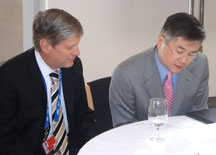
ASTM Participates in Asia-Pacific Economic Cooperation Conference Conference
Conference on Green Buldings and Growth Emphasizes Use of Standards in Reducing Trade Barriers
Minimizing barriers to trade for green building products, materials and services in the Asia Pacific region through cooperation on standards and conformity assessment took significant steps forward at the March 3-4 Conference on Green Buildings and Green Growth, which focused on the enabling role of standards and trade.
The U.S. government partnered with ASTM International and approximately 20 other trade associations, standards development organizations and conformity assessment bodies to plan and host the conference, which attracted 150 participants from all of the 21 APEC member economies. The two-day conference was one event in a series leading up to the first Asia-Pacific Economic Cooperation senior officials meetings in 2011 hosted in Washington, D.C.
The conference featured keynote addresses by Ronald Sims, undersecretary for housing and urban development, and Frank O'Brien-Bernini, vice president and chief sustainability officer of Owens Corning.
The building products sector is one of the highest performing manufacturing export sectors for the United States, with exports of $30 billion (2009) supporting an estimated 153,000 jobs. Key topics of the conference included a discussion of a recently completed APEC survey of its members' policies on green buildings and both voluntary and mandatory requirements for market entry. Business representatives discussed their perspectives on the opportunities and challenges of trading green building products in the Asia-Pacific market.
APEC is a 21-member intergovernmental forum that works through private sector input to reduce tariffs and other trade barriers across the Asia-Pacific region. APEC represents 60 percent of global production, 47 percent of world trade and one-third of the earth's population.
Increasing economic engagement in the Asia-Pacific region reflects President Obama's priorities for the United States as the APEC host for 2011, which included strengthening regional economic integration and expanding trade, promoting green growth and advancing regulatory cooperation and convergence.
The Conference Program
Six conference sessions covered a broad range of sustainable building topics from the manufacture to the export of green products and materials. Ten economies sent speakers: Australia, Canada, Chile, China, Chinese Taipei, Indonesia, Japan, New Zealand, Singapore and the United States.
In his opening remarks, James A. Thomas, president of ASTM International, paved the way for meaningful dialogue during the two-day program. "As in the standards development work taking place in ASTM and in the standardization system in the United States, this conference is a demonstration of the benefits and value of the public-private partnership," said Thomas. "From the development of the proposal to the delivery of this conference, the collaboration of public and private stakeholders has been a fundamental component of the effort and keystone to its success."
U.S. Secretary of Commerce Gary Locke, in his remarks on the second day of the conference, said, "At [the U.S. Department of] Commerce, we are working closely with the U.S. Trade Representative and our counterparts in Asia to ensure the Trans-Pacific Partnership makes important headway in standards development. As always, APEC will be central to this effort, and I want to thank the several APEC economies and private sector organizations that are co-sponsoring this green growth conference."
United States government agencies presenting at the program were the Environmental Protection Agency, the Department of Energy, the Department of Housing and Urban Development, the Department of Commerce and the Office of the U.S. Trade Representative.
Private sector representation included associations representing the building industry and codes and standards developing organizations such as ASTM International, the American Society of Heating, Refrigerating and Air-Conditioning Engineers, the American Wood Council, the Construction Specifications Institute, the International Association of Plumbing and Mechanical Officials, the International Code Council, the National Fenestration Rating Council, and UL Environment.
The conference was part of the project, "Sustainability in Building Construction (Commercial Buildings) – Efficiency and Conservation," overseen by the U.S. Department of Commerce and ASTM International to build awareness and promote participation in developing technical requirements that will facilitate trade in the sustainable construction of commercial buildings. A further aspect of the project concerns uniformity in measuring claims regarding sustainable products and systems. Other project plans include case studies and a second conference later in the year.
Survey on Sustainability in Building Construction
The sustainability project began with a survey of the APEC member economies to establish a baseline of information on the regulation, standards and trade of sustainable commercial construction today. The survey was co-sponsored by the Air Conditioning, Heating and Refrigeration Institute; the Aluminum Association; the International Code Council; and the International Association of Plumbing and Mechanical Officials. In addition, support from NFRC helped to realize the event. Results of the survey were presented at the workshop and will be posted online.
Future Green Growth in the Asia-Pacific Region
The Green Buildings and Growth workshop provided a practical landscape for all stakeholders in the Asia-Pacific region to be in communication. Creating an early dialogue on standards under development before governments proceed in adopting codes and regulations reduces the potential for technical barriers to trade in the green building construction arena.
Outcomes of the project on building construction sustainability will serve to encourage investment in environmental goods and services, foster good regulatory practices and maximize the region's economic and social well-being.
For more information on the APEC 2011, visit www.apec2011.gov.
 SN Home
SN Home Archive
Archive Advertisers
Advertisers Masthead
Masthead RateCard
RateCard Subscribe
Subscribe Email Editor
Email Editor